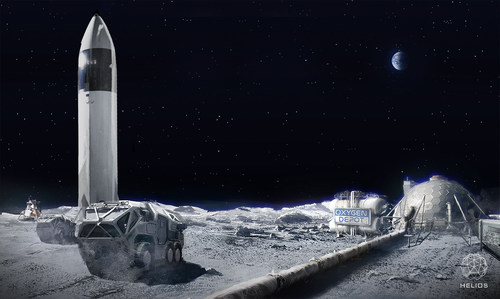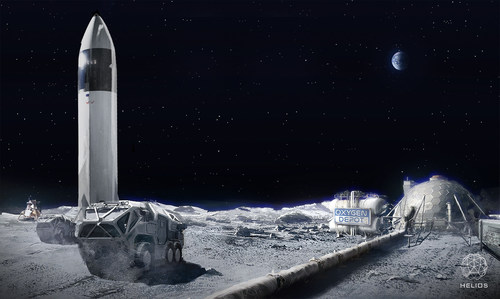Nach den Beinnaheerfolg einer ersten Mondladung durch einen israelischen Satelliten, versteht man in den politischen Entscheidungsetagen Israels, in der Start-up Szene und Wissenschaft sehr genau, dass eine der Zukünfte im Weltraum und in innovativer Weltraumtechnologie liegen. Einen zweiten Versuch zu einer erfolgreichen Mondlandung will man 2024 starten.
Israelische Unternehmen wie beispielsweise Aleph-Farm bereiten sich intensiv darauf vor. So will Aleph-Farm vegane Steaks am Mond produzieren, um nur eines von vielen Beispielen zu nennen.
Bei israelischen Universitäten gehört es mittlerweile zum guten Ton in Eigenregie Mikro- und Naonosatelliten von den Dächern der Universitäten in die Umlaufbahn zu schicken, wie die Universität Tel Aviv oder das Technion. Oder eine nachhaltige Raumfahrtwirtschaft zu etablieren. Die Liste lässt sich lange fortsetzen.
So überrascht die jüngste Initiative nicht und setzt schon bekannte Anstrengungen fort. Bis dato hat man schon bereits rund 160 Millionen NIS investiert. Nun legte man 18,5 Millionen NIS auf den Tisch des Hauses, die an 11 Unternehmen gehen.

In der Pressemitteilung heißt es ausführlich: ” (…) Die israelische Raumfahrtagentur im Ministerium für Innovation, Wissenschaft und Technologie bietet in Zusammenarbeit mit der israelischen Innovationsbehörde Unterstützung im Raumfahrtsektor an, um Forschung und Entwicklung für neue, innovative und fortschrittliche technologische Lösungen und Produkte im Raumfahrtsektor zu fördern, einschließlich der Nutzung der Weltraumumgebung oder durch Integration, Verarbeitung und Analyse von Daten aus dem Weltraum. Im Rahmen dieses Programms, das seit 2012 besteht, wurden bereits 62 FuE-Projekte mit insgesamt rund 160 Millionen NIS gefördert.
Ziel des Programms ist es, das Wissen und die technologischen Entwicklungskapazitäten der israelischen Raumfahrtindustrie zu stärken, das Wachstum von Start-ups im Bereich der Raumfahrttechnologien zu fördern, die Nutzung bestehender Technologien für die Raumfahrt zu unterstützen, Wissenslücken in Bezug auf das Geschehen auf den globalen Raumfahrtmärkten zu verringern, die Wettbewerbsfähigkeit der israelischen Industrie zu verbessern und die Nutzung wissenschaftlicher Erkenntnisse aus der Raumfahrttechnologie durch die israelische Industrie zu steigern. (…)”
11 Unternehmen greifen nach den Sternen
Die 11 israelischen Unternehmen, die schließlich ausgewählt wurden sind und unter welchen die Forschungsgelder verteilt werden:
Eicha Communication Systems
Paxis
Terra Space Lab
N.S.L. Communications
GorillaLink
GreenOnyx
HELIOS
SCD
Space Plasmatics
NewRocket
Ramon Space
Produktion von Sauerstoff&Wasserstoff am Mond
Alles großartige Vorhaben und Unternehmen, die Israels Innovationskraft unterstreichen. Am spannendsten finde ich das Unternehmen HELIOS, welches Sauerstoff am Mond produzieren möchte.
Helios ist ein israelisches Unternehmen, das 2018 gegründet wurde und von der Israel Space Agency im Ministerium für Innovation, Wissenschaft und Technologie, dem Energieministerium und der Innovationsbehörde unterstützt wird. Die Vision des Unternehmens ist es, nachhaltiges menschliches Leben auf der Erde und darüber hinaus zu ermöglichen.
In der Pressemitteilung heißt es: “Es handelt sich um ein israelisches Start-up-Unternehmen, das eine Technologie zur Erzeugung von Sauerstoff auf dem Mond entwickelt hat. Die Technologie von Helios wird Sauerstoff auf dem Mond produzieren, wobei ein Reaktor verwendet wird, der von den Sanddünen des Mondes gespeist wird und einen Prozess durchführt, der Sauerstoff und Oxide von der Mondoberfläche erzeugt.
Der Prozess erfordert keine von der Erde mitgebrachten Verbrauchsmaterialien und ermöglicht daher landwirtschaftlichen Kolonien “von der Erde zu leben” auf permanenten Basen, die weit von unserem Planeten entfernt sind. Der Sauerstoff ist für den menschlichen Konsum zum Atmen notwendig, wird aber größtenteils für Starts und für die Bewegung von Raumfahrzeugen verwendet, da Sauerstoff einen Verbrennungsprozess erfordert.
Die revolutionäre Technologie, die von Helios entwickelt wird, produziert den notwendigen Sauerstoff aus dem Mondsand, ohne verbrauchbare Rohstoffe von unserem Planeten zu verwenden, und spart so Kosten und ermöglicht den Transport größerer Fracht auf Kosten des Sauerstoffs.
Die Produktion von Sauerstoff auf dem Mond wird nicht nur die ständige Anwesenheit von Menschen auf dem Mond unterstützen, wie z. B. Artemis und Lunar Gateway, sondern auch Deep Space-Missionen, z. B. bemannte Missionen zum Mars. Da die Schwerkraft auf der Erde viel stärker ist als auf dem Mond, benötigt man 25 Mal mehr Energie, um Sauerstoff von der Erde in den nahen Weltraum zu transportieren als vom Mond aus.
Im Grunde genommen wird es viel billiger sein, ein Raumschiff mit Sauerstoff vom Mond zu betanken als mit Sauerstoff von der Erde, selbst wenn das Raumschiff die Erde umkreist. Das Hauptverfahren, das Helios entwickelt, heißt “Molten Regolith Electrolysis” (Elektrolyse von geschmolzenem Regolith), wobei das Regolith im Kern verwendet wird.
Dabei wird das Mondregolith bei 1600 Grad Celsius geschmolzen und anschließend durch Elektrolyse der gespeicherte Sauerstoff für die Nutzung entzogen. Helios wird bis 2024 drei kleine Ladungen zum Mond bringen, um die Technologie zu demonstrieren und den Prozess unter realen lunaren Umgebungsbedingungen zu optimieren.”
Zuletzt gab HELIOS eine Kooperation mit Eta Space bekannt, um das Projekt „Sauerstoff auf dem Mond“ zu beschleunigen. Zwei Weltraumtechnologieunternehmen, Helios und Eta Space, gaben im August 2022 bekannt, dass sie ihre Kräfte bündeln, um das Sauerstoffproblem im Weltraum zu lösen.
Wenn die Menschheit eine nachhaltige Präsenz jenseits der Erde haben soll, benötigen die wiederverwendbaren, mit Methan betriebenen Raketensysteme flüssigen Sauerstoff im Verhältnis 1:4, sodass die einzige kostengünstige Lösung zum Auftanken im Orbit darin besteht, Sauerstoff auf dem Mond zu erzeugen und zu speichern auf dem Mars.
Helios, das von der Israel Space Agency (ISA) unterstützt wird und kürzlich die Finanzierung durch mehrere Risikokapitalfirmen angekündigt hat, hat einen elektrochemischen Reaktor entwickelt, der in der Lage ist, Sauerstoff aus dem Mondregolith zu extrahieren, der zu etwa 45 % aus Sauerstoff besteht. Ihre proprietäre Technologie und ihr Verfahren haben sich als effektiv erwiesen und werden terrestrisch für die Gewinnung anderer Elemente wie Eisen verwendet.
Eta Space, mit Sitz im Space Valley von Florida, ist auf die Produktion, Lagerung und den Transfer von kryogenen Treibstoffen spezialisiert. Sein Gründer und CEO, Dr. William Notardonato, arbeitete 30 Jahre lang bei der NASA und ist Spezialist für kryogene Technologien, insbesondere für flüssigen Sauerstoff und flüssigen Wasserstoff.
ENGLISH
After the near success of the first moon landing by an Israeli satellite, Israeli political decision-makers, the start-up scene and the scientific community understand very well that one of the futures lies in space and innovative space technology. A second attempt at a successful moon landing is planned for 2024.
Israeli companies such as Aleph-Farm are preparing intensively for this. Aleph-Farm wants to produce vegan steaks on the moon, to name just one of many mindblowing examples.
It is now common practice for Israeli universities, such as Tel Aviv University or the Technion, to send micro and naonosatellites into orbit from the roofs of their universities on their own initiative. Or to establish a sustainable space economy. The list goes on and on.
So the latest initiative is not surprising and continues already known efforts. To date, about 160 million NIS have already been invested. Now, NIS 18.5 million has been put on the table of the House, which will go to 11 companies.

The press release states in detail: ” (…) The Israel Space Agency in the Ministry for Innovation, Science and Technology, in partnership with the Israel Innovation Authority, offers support in the space sector that encourages research and development for finding new, innovative and advanced technological solutions and products in the space sector, including the use of the space environment, or through integration, processing and analyzing data from space. In the framework of this program, which exists since 2012, 62 R&D projects already won a total of around NIS160 million.
The goal of the program is to strengthen the knowledge and the technological development capabilities of the space industry in Israel, to encourage the growth of space technologies startups, to encourage the use of existing technologies for space, reduce knowledge gaps with regards to what is happening in the global space markets, improve Israeli industry’s competitiveness and increase Israeli industry’s use of scientific knowledge accrued from space technologies. (…)
11 companies reach for the stars
Eicha Communication Systems
Paxis
Terra Space Lab
N.S.L. Communications
GorillaLink
GreenOnyx
HELIOS
SCD
Space Plasmatics
NewRocket
Ramon Space
Production Oxygen&Hydrogen on the Moon
All great projects and companies that underline Israel’s innovative strength. The company I find most exciting is Helios, which wants to produce oxygen on the moon.
Helios is an Israeli company founded in 2018, supported by the Israel Space Agency at the Ministry of Innovation, Science and Technology, Ministry of Energy and the Innovation Authority. The company’s vision is to enable sustainable human life on Earth and beyond.
The press release says:”This is an Israeli startup that has developed technology to produce oxygen from the moon. Helios’s technology will produce oxygen across the moon, using a reactor the is fed by the moon’s sand dunes, and performs a process that produces oxygen and oxides from the moon’s surface.
The process does not require consumables to be brought from the earth and therefore allows agricultural colonies “to live from the earth” on permanent bases that are distant from our planet.
The oxygen is necessary for human consumption for breathing, but most of it will be used for launches and for the movement of space vehicles, since oxygen requires a combustion process.
The revolutionary technology being developed by Helios produces the necessary oxygen from the moon’s sand, without using consumable raw materials from our planet, and in so doing saves costs and allows the transportation of larger cargo at the expense of the oxygen. Producing oxygen on the moon won’t only support permanent human presence on the moon, like the Artemis and Lunar Gateway, but also deep space missions, for example manned missions to Mars.
Since the force of gravity on earth is far stronger than that of the moon, you need 25 times more energy in order to transport oxygen from earth to near space than to do it from the moon.
Essentially, it will be much cheaper to fuel a spaceship with oxygen from the moon than with oxygen from the earth, even if the spaceship is orbiting the earth. The main process that Helios is developing is called Molten Regolith Electrolysis, while using the regolith in the core.
It melts the moon regolith at 1600 degrees Celsius and afterwards, through electrolysis, removes stored oxygen for use. Helios will launch three small cargoes to the moon by 2024, in order to demonstrate the technology and to optimize the process under real moon environmental conditions.”
Most recent HELIOS announced a co-operation with Eta Space to accelerate the project ‘oxygen on the moon’. Two space tech companies, Helios and Eta Space, announced in August 2022 they are joining forces to solve the problem of oxygen in space.
If humanity is to have a sustainable presence beyond Earth, the reusable methane-fueled rocket systems need liquid oxygen at a ratio of 1:4, so the only cost-effective solution to refueling in orbit is to create and store oxygen on the Moon and on Mars.
Helios, which is backed by the Israel Space Agency (ISA) and which recently announced funding from several venture capital firms, has developed an electrochemical reactor capable of extracting oxygen from the lunar regolith, which is made of approximately 45% oxygen. Their proprietary technology and process has proven effective and is being used terrestrially for the extraction of other elements, such as iron.
Eta Space, located on the Space Valley of Florida, specializes in production, storage and transfer of cryogenic propellants. Its founder and CEO, Dr. William Notardonato, worked for 30 years at NASA and is a specialist in cryogenic technologies, specifically liquid oxygen and liquid hydrogen.